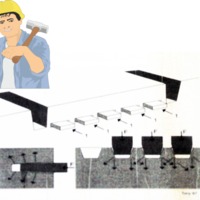Question 2
Questions Item Type Metadata
Description
2nd TEST: Arch-quarryman: Pretty good. It seems that you know how to use the wedges. The wedges are a tool of quarrymen that existed since ancient times, when all people believed in many gods. Nowadays however, we use another method to extract the marble we want from the bedrock: we open around the part of the block that we want to remove a lot of holes with a needle, one next to the other. Can you show me the traces left by this technique?
QuestionText
Did you find the new location?
Correct Answer
YES
DescriptionCorrectAnswer
Well done. In the drawing cited by archaeologists, the quarrying technique which was in use during the early Christian era is depicted.
Instead of using wedges the quarryworkers opened with the needle (a metal rod with a sharp tip that they hit with a small hammer) called the epikopano, small holes around the part that they wanted to remove of the bedrock. This technique is called pointillé (dotted, spotted) because it leaves traces like dots (in French point) on the marble. Although in Alyki this technique is detected in the Roman – early Christian quarries, it is generally known from the ancient times.
Go to the next spot to participate in the third Test.
Instead of using wedges the quarryworkers opened with the needle (a metal rod with a sharp tip that they hit with a small hammer) called the epikopano, small holes around the part that they wanted to remove of the bedrock. This technique is called pointillé (dotted, spotted) because it leaves traces like dots (in French point) on the marble. Although in Alyki this technique is detected in the Roman – early Christian quarries, it is generally known from the ancient times.
Go to the next spot to participate in the third Test.
Option A
NO
DescriptionOptionA
It doesn’t matter. Maybe a mistake was made with the identification of the location. In the drawing cited by archaeologists, the quarrying technique which was in use during the early Christian era is depicted.
Instead of using wedges the quarryworkers opened with the needle (a metal rod with a sharp tip that they hit with a small hammer) called the epikopano, small holes around the part that they wanted to remove of the bedrock. This technique is called pointillé (dotted, spotted) because it leaves traces like dots (in French point) on the marble. Although in Alyki this technique is detected in the Roman – early Christian quarries, it is generally known from the ancient times.
Go to the next spot to participate in the third Test.
Instead of using wedges the quarryworkers opened with the needle (a metal rod with a sharp tip that they hit with a small hammer) called the epikopano, small holes around the part that they wanted to remove of the bedrock. This technique is called pointillé (dotted, spotted) because it leaves traces like dots (in French point) on the marble. Although in Alyki this technique is detected in the Roman – early Christian quarries, it is generally known from the ancient times.
Go to the next spot to participate in the third Test.
Lat
40.60122
Lon
24.73977
PointID
ALK.19.04.01
TextID
Original text of the spot Quarrying techniques during the early Christian period.
In the drawing cited by archaeologists, the quarrying technique which was in use during the early Christian era is depicted.
Instead of using wedges the quarryworkers opened with the needle (a metal rod with a sharp tip that they hit with a small hammer) called the epikopano, small holes around the part that they wanted to remove of the bedrock. This technique is called pointillé (dotted, spotted) because it leaves traces like dots (in French point) on the marble. Although in Alyki this technique is detected in the Roman – early Christian quarries, it is generally known from the ancient times.
In the drawing cited by archaeologists, the quarrying technique which was in use during the early Christian era is depicted.
Instead of using wedges the quarryworkers opened with the needle (a metal rod with a sharp tip that they hit with a small hammer) called the epikopano, small holes around the part that they wanted to remove of the bedrock. This technique is called pointillé (dotted, spotted) because it leaves traces like dots (in French point) on the marble. Although in Alyki this technique is detected in the Roman – early Christian quarries, it is generally known from the ancient times.
Files
Collection
Citation
“Question 2,” iGuide Repo, accessed December 5, 2025, http://ubuntu01.ceti.gr/omeka/items/show/2109.
Item Relations
| This Item | dcterms:isPartOf | Item: At the quarries of Alyki |

